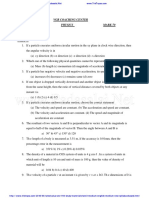0% found this document useful (0 votes)
1K views1 page11th Physics First Midterm Important Questions
The document outlines important questions for the 11th Physics First Midterm Exam, categorized into short answer and long answer sections. Key topics include basic and derived quantities, significant figures, types of errors, scalar and vector quantities, equations of motion, projectile motion, and vector addition. It emphasizes derivations and explanations related to motion and measurement techniques.
Uploaded by
laughinglawsqCopyright
© © All Rights Reserved
We take content rights seriously. If you suspect this is your content, claim it here.
Available Formats
Download as PDF, TXT or read online on Scribd
0% found this document useful (0 votes)
1K views1 page11th Physics First Midterm Important Questions
The document outlines important questions for the 11th Physics First Midterm Exam, categorized into short answer and long answer sections. Key topics include basic and derived quantities, significant figures, types of errors, scalar and vector quantities, equations of motion, projectile motion, and vector addition. It emphasizes derivations and explanations related to motion and measurement techniques.
Uploaded by
laughinglawsqCopyright
© © All Rights Reserved
We take content rights seriously. If you suspect this is your content, claim it here.
Available Formats
Download as PDF, TXT or read online on Scribd
/ 1
























































